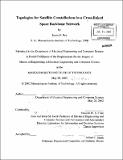| dc.contributor.advisor | Vincent W.S. Chan. | en_US |
| dc.contributor.author | Bau, Jason H. (Jason Hsi-Chieh), 1978- | en_US |
| dc.contributor.other | Massachusetts Institute of Technology. Dept. of Electrical Engineering and Computer Science. | en_US |
| dc.date.accessioned | 2007-08-03T18:43:39Z | |
| dc.date.available | 2007-08-03T18:43:39Z | |
| dc.date.copyright | 2002 | en_US |
| dc.date.issued | 2002 | en_US |
| dc.identifier.uri | http://hdl.handle.net/1721.1/38441 | |
| dc.description | Thesis (M.Eng.)--Massachusetts Institute of Technology, Dept. of Electrical Engineering and Computer Science, 2002. | en_US |
| dc.description | Includes bibliographical references (p. 101). | en_US |
| dc.description.abstract | An evolutionary space data network can be formed from satellites serving as both backbone and user-access nodes connected via high-speed cross-links. Such a space backbone network should support spacecraft-to-ground and spacecraft-to-spacecraft links for users of various altitudes (LEO, MEO, GEO and HEO). One main consideration in the design of such a space network is the physical altitude and topology of the backbone satellite constellation. In this thesis, different GEO, MEO, and LEO configurations are considered as backbone topologies to serve the projected user altitudes and requirements. First, exact constellations are determined for each proposed configuration that meet the user coverage requirements while maximizing coverage efficiency. The complexities of these constellations are then compared using constellation parameters such as altitude, and the number of orbital planes required, and the number of satellites required per plane, as well as individual satellite parameters like the number of antennae required, the necessary slewing rate of each antenna, the power required by each antenna, and the physical placement of these antennae on the satellites. The complexity parameters of each individual satellite will be determined for two of the types of communications links used on the satellite, namely links between the user satellites and backbone satellites and links between backbone satellites. These parameters are then used in a speculative cost model to determine the cost versus complexity of each constellation. Through these calculations, a GEO backbone consisting of three satellites is determined to require a minimum number of apertures for both types of links as well as allowing an optimal onboard placement of these apertures. Thus, it possesses cost vs. complexity characteristics superior to other constellations and should be the choice for a space-borne data backbone network. | en_US |
| dc.description.statementofresponsibility | by Jason H. Bau. | en_US |
| dc.format.extent | 101 p. | en_US |
| dc.language.iso | eng | en_US |
| dc.publisher | Massachusetts Institute of Technology | en_US |
| dc.rights | M.I.T. theses are protected by copyright. They may be viewed from this source for any purpose, but reproduction or distribution in any format is prohibited without written permission. See provided URL for inquiries about permission. | en_US |
| dc.rights.uri | http://dspace.mit.edu/handle/1721.1/7582 | |
| dc.subject | Electrical Engineering and Computer Science. | en_US |
| dc.title | Topologies for satellite constellations in a cross-linked space backbone network | en_US |
| dc.type | Thesis | en_US |
| dc.description.degree | M.Eng. | en_US |
| dc.contributor.department | Massachusetts Institute of Technology. Department of Electrical Engineering and Computer Science | |
| dc.identifier.oclc | 51111999 | en_US |
